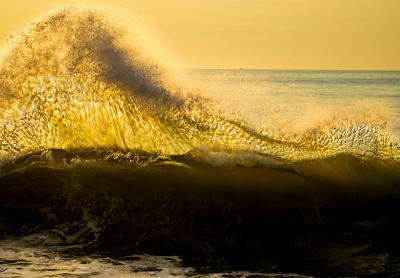Nature Notes: No Two the Same

Water and air. Two of the basic elements of our planet, and when the water occupies the surface they are intimately related. These two forms of matter exchange gases both during the day and the night. Such exchanges occurring throughout every second of every day no matter whether cold or hot and are the chemical reactions responsible for the existence of earth’s life and life functions. Not only that, they interact in many other ways, one of which is making waves.
There is never a moment when somewhere in the world, air and water are not creating waves, big or small. The height of every wave is chiefly determined by two factors, moving air and the size of the water body. Thus ocean waves are larger than lake or bay waves, lake or bay waves larger than river or creek waves, river and creek waves larger than pond and stream waves. The last are rarely more than mere ripples. When waves wash ashore or suddenly encounter a shallow bottom they may momentarily rise up before falling or waning.
Some ocean waves travel thousands of miles before reaching the coast. As long as the wind driving it doesn’t die out, a single wave can start out, say, in the middle of the Pacific Ocean and travel all the way to Asian or American shores without losing amplitude or velocity. The speed and direction of the wind determines a given wave’s height and bearing.
When you look at one of these far-traveling waves on its way to shore, you get the impression of massive movement and, perhaps, think that the water about to break traveled a very long way to get here, but it never does. The wave is a wave; it travels toward you, but not the water it represents. The water merely moves up and down vertically. The wind and the particles of air and dust that accompany the wave often come from far away. If the water actually traveled with the wind, the water at the edge of the shore would become thousands of feet deep. Instead, after the wave breaks, it becomes shallow again.
The break of each wave is different from the break of every other wave that follows. One might observe the curling over of the wave, its subsequent collapse onto the near shore, the spume rushing up onto the beach and its quick retreat back into the ocean. The larger the wave the larger the backrush of water, thus the dangerous rips that can carry you off and out to sea if you are not on your guard. If it weren’t for large ocean waves there wouldn’t be the very popular sport of surfing. Have you ever seen someone surf in Gardiner’s Bay or Three Mile Harbor?
An expert surfer or kayaker could travel mile upon mile starting way out at sea and surfing down and up the slopes of the waves as they move toward land. But beware of the last 30 feet or so, especially should the shore have rocks mixed in with the sand.
If the waves approach the shore at an angle, such that they break in a line one after another, a long-shore current can form. If at the Montauk ocean beach the waves are driven by a southeasterly wind, for example, the easternmost will break the first, followed by the next easternmost and so on down the line. Such lines of waves during tropical storms and northeasters are capable of moving not only sand toward the west but also small rocks caught up in the long-shore current. It is these large storms with easterly winds that account for most of the erosion of the Montauk headlands and the net movement of sand from east to west. The ocean beaches of Amagansett capture much of this sand, but very little in the way of rocks and stones, which leave the drift west early on.
Bluff Road in Amagansett is so called because in very early times it was a duney bluff south of which the sea began. In the notorious Hurricane of 1938 the water came up to Bluff Road, 300 to 400 yards north of the beach and dunes it passed over on its way. In fact, the famous Double Dunes are actually lines of dune ridges that ran to and ran up upon the fertile fields — now mostly developed with houses — south of Further Lane between the Village of East Hampton and Napeague. As long as they continue to receive sand and other soil particles from the east they will retreat only a minuscule amount if at all.
Some of the sand from the east washes back out to sea when the waves are hitting the shore head-on in a line from east to west. The back currents get them 100 feet to 100 yards offshore, where they come to rest as sand bars or reefs. They can slowly move back onshore and replenish the beach when conditions are right — there are no large cyclonic storms and the waves are moderate, particularly so in the summer.
If our eyes and minds were capable of stop-action in the way that modern cameras are, we could easily see that each wave when it breaks is different. Each wave’s impact on the shore is thus different, if even minutely so. Dell Cullum, an East Hampton Town trustee and wildlife rescuer and rehabber, is also an excellent videographer and photographer. He has spent many hours capturing the breaking and subsequent splashes of hundreds of waves hitting local beaches in stop-action. Thus you can see how each wave’s crash pattern is different and also beautiful. He has compiled some of his best shots in three small photographic volumes titled “Aquatic Ballet.”
After slowly perusing the photographs in these little books you will see and experience ocean waves in a very different way forevermore.
Larry Penny can be reached via email at [email protected].
